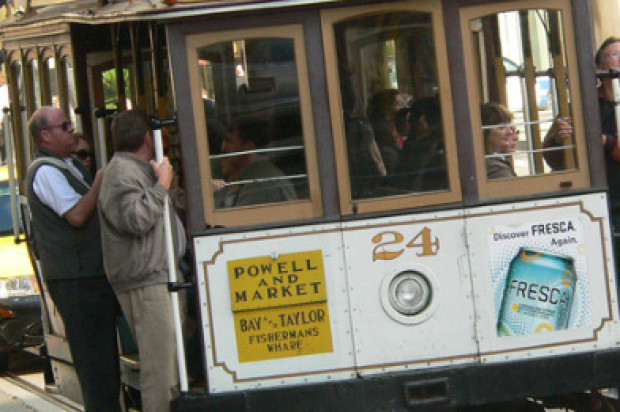
After two San Francisco cable car operators were seriously injured recently by motorists who illegally passed stopped cable cars, San Francisco police will be cracking down on motorists who flout the law.
San Francisco police Chief Greg Suhr said 15 citations have already been issued this week to drivers who ignore the city’s “Do Not Pass” law. He said anyone who passes the stopped cable cars can expect to be issued a $238 ticket.
The San Francisco Municipal Transportation Agency, the San Francisco Police Department, and Transport Workers Union Local 250-A announced key steps today they are supporting to help keep operators and riders of the cable cars safe.
California law requires drivers to stop a safe distance behind any trolley or streetcar and remain stopped for the duration of passenger boarding and exiting.
Suhr said that no one would ever think of passing a school bus for fear of injuring children and that motorists need to adopt that same mindset when approaching cable cars on the road.
Cheryl Brinkman, vice-chairman of the SFMTA’s board of directors, said it is important to remember that not only are the cable cars one of the city’s most famous tourist attractions, but the operators are “beloved icons” as well, and need to be cherished.
Chee Freeman, a cable car operator of 15 years who has worked for the SFMTA for 31 years and was manning his post today on the California cable car line, said the disregard for pedestrians exhibited by some motorists can be “disturbing.”
He said a lot of motorists seem to forget that pedestrians come first.
“People come first, always,” Freeman said.
He notes, however, that since the cable cars began operation in 1873, people’s concept of time has changed and the roads are not designed with cable car safety in mind.
He said that while he loves his job, roughly five to 10 times a day he sees drivers dangerously passing his cable car and is constantly worrying about the safety of his passengers.
Freeman said he was given a stop sign to hold and wave from the side of the cable car when passengers are loading and unloading, but that sometimes the cable car is so crowded it is difficult to hold out the stop sign before passengers start disembarking.
He said it would be great if the cable cars had a similar mechanism to school buses, with the automated stop signs and lights.
Eric Williams, president of TWU Local 250-A, said his office is working to educate the tourist industry about the rules of the road and wants the city to go further than just its Vision Zero commitment to eliminate traffic deaths in the city over the next decade.
Williams said on roads where the cable cars run, the city should consider diverting private vehicles or lowering speed limits.
“Let’s stop being reactive, let’s be proactive,” Williams said.
Williams said that unfortunately, the cable cars aren’t designed to pull up to the sidewalk, so people are sometimes forced to enter and exit the cable cars in the middle of the road.
He said there almost no pedestrian islands, bulbouts or loading zones to protect employees or pedestrians.
The two cable car workers who were struck by motorists on the Powell Street cable car line survived, but were critically injured, Williams said.
An allegedly drunk motorcyclist struck one of the operators in June, while a man driving a minivan in April struck the other.
SFMTA director of transportation Ed Reiskin said today that those two incidents this year have “doubled our resolve” to get the public to understand that this law is “a matter of life and death” and that violations will not be tolerated.
Hannah Albarazi, Bay City News









